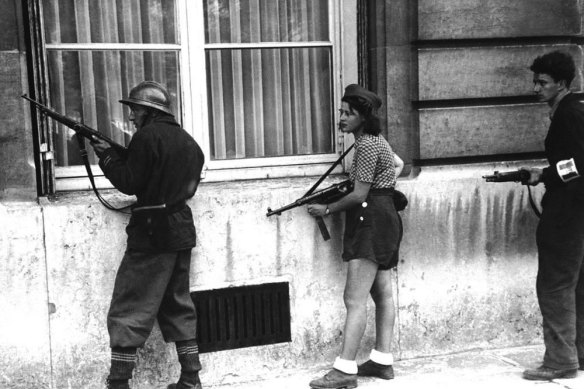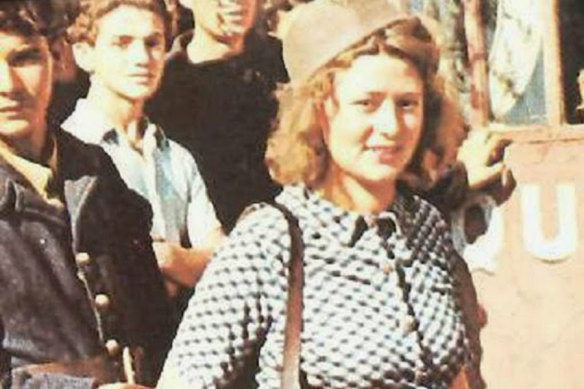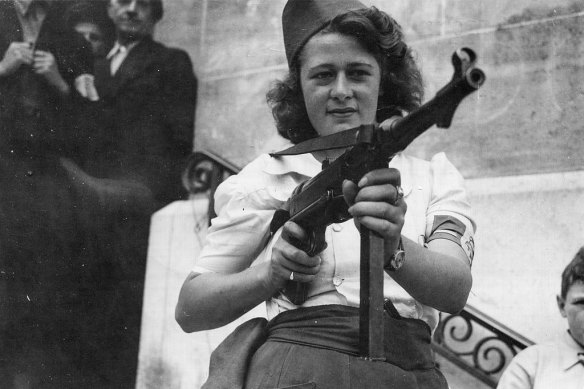Iconic French Resistance fighter Simone Segouin dies
Simone Segouin, who has died aged 97, was a French Resistance fighter who was immortalised in photographs taken by Robert Capa and became a symbol of female defiance.
She was born into a farming family on October 3, 1925, in Thivars, near Chartres, a tomboyish only daughter with three brothers, and was largely brought up by her father, a decorated veteran of World War I.
Simone Segouin in 1944 in the iconic photo.Credit:International Newsphotos
When Germany invaded France in 1940 the 14-year-old Simone left school to work on the family farm, and in 1943 she joined the Francs-Tireurs et Partisans (FTP, Free-shooters and Partisans) – an alliance of militant communists and nationalists like Simone.
She was given false identity papers as Nicole Minet from Dunkirk (where records had been destroyed in the bombing at the start of the war, making it difficult to check details in identity cards).
On her first mission she stole a German military bicycle, which she re-sprayed as her “reconnaissance vehicle”, and was soon involved in delivering messages between FTP hide-outs.
Soon, after weapons training, she was taking part in combat missions, helping to derail a train and blow up bridges.
Simone Segouin the 18-year-old French resistance fighter in 1944.
Asked after the war whether she had ever killed someone, she recalled that on July 14, 1944 she and two comrades had taken part in an ambush: “Two German soldiers went by on a bike, and the three of us fired at the same time, so I don’t know who exactly killed them.”
In August 1944 she was involved in the liberation of her home village of Thivars, where she was spotted by the Hollywood director George Stevens, then serving in a US Army film unit, after she helped to capture 25 German soldiers.
His film footage released after the Liberation showed a defiant teenager in blue shorts, a black-and-white top with a red sash and a khaki cap, toting her Schmeisser MP 40.
French Resistance fighter Simone Segouin has died aged 97.Credit:US National Achives
She went on to help in the liberation of Chartres, and it was on August 25, during a visit to the city by the Free French leader General de Gaulle, that she was spotted by the American reporter Jack Belden and the photographer Robert Capa, eating a baguette, her machine gun by her side.
They spoke to her as women who had taken up with German soldiers during the occupation were being dragged into the streets to have their hair forcibly shaved off.
A month later, in September 1944, Capa’s photographs of “Nicole” in shorts and a beret, brandishing her sub-machine gun, appeared in a Life magazine feature written by Belden under the headline “The Girl Partisan of Chartres”. The images were subsequently syndicated around the world.
“I could find no trace of what is conventionally called toughness in Nicole,” Belden reported.
“After routine farm life, she finds her present job thrilling and exhilarating. Now that the war is passing beyond her own home district she does not think of going back to the farm. She wants to go on with the Partisans and help free the rest of France.”
Indeed by this time, Simone Seguin had joined de Gaulle as he headed towards Paris, where she took part in the battles for the city as the outnumbered German garrison fought a hopeless rearguard action.
Meanwhile, she had fallen in love with Roland Boursier, a dashing FTP commander who had recruited her in 1943 to act as his runner.
“I studied her for a while to see what were her feelings,” Boursier said later.
“When I discovered she had French feelings I told her little by little about the work I was doing. I asked her if she would be scared to do such work. She said, ‘No. It would please me to kill Boche [Germans].’ ”
They had a long relationship which produced six children, though they never married.
In 1946 Simone Segouin was promoted to second lieutenant and was awarded the Croix de Guerre. She went on to become a paediatric nurse in Chartres and later settled in nearby Courville-sur-Eure, where a street is named after her.
The photographs taken by Robert Capa helped to publicise the role of female resistance fighters and change attitudes in France. In 1945 French women voted for the first time in local and national elections.
In 2021, Simone Segouin was appointed a Chevalier of the Légion d’honneur.
“I was fighting for the resistance, that’s all,” she explained. “If I had to start over, I would, because I have no regrets. The Germans were our enemies, we were French.”
Telegraph, London
Get a note directly from our foreign correspondents on what’s making headlines around the world. Sign up for the weekly What in the World newsletter here.
Most Viewed in World
From our partners
Source: Read Full Article


